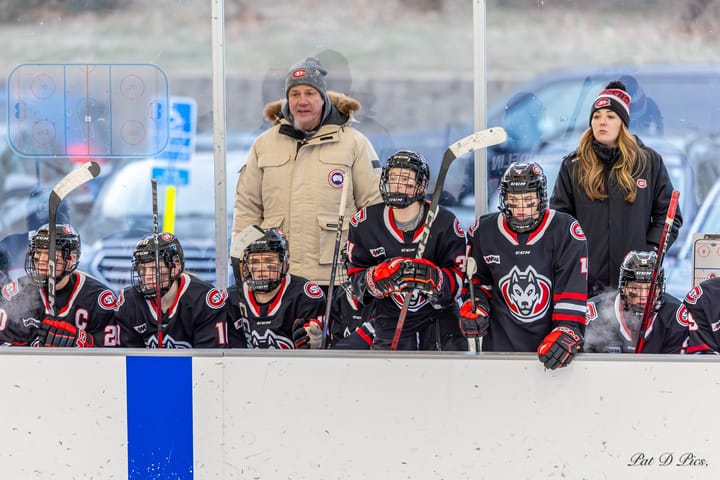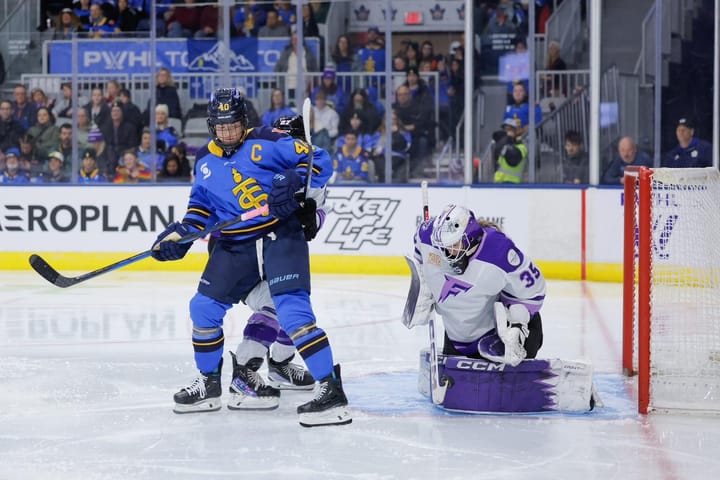Lovisa Selander is the best goalie you haven’t heard of
The NCAA’s best goalie talks gear, international styles, and her unexpected choice of warm-up video
Lovisa Selander isn’t exactly under the radar. The RPI senior goalie has been voted ECAC Goalie of the week four times in her college career and has been the subject of admiring posts on fan sites and stories on local news, as well as being singled out here on The Ice Garden as one of the top NCAA goalies of this year.
Related
The top five NCAA goalies this season
A native of Sollentuna, Sweden, she broke Brianne McLaughlin’s 3,809-save record for most career saves in Division 1 (and as of yesterday, with a 49-save shutout against Cornell, has beaten Nicole Hensley’s 4,094, which isn’t the official record because in Hensley’s freshman year Lindenwood was still transitioning to D1). With the quarter final decider today, she's bound to add to her current 4098 saves and extend her lead at the top of the record books.
She’s a reliable backup for the Swedish National Team, and has backstopped RPI to its best season since 2009-2010, the last time RPI had a win percentage over .50. (In that season, RPI’s goalie was future pro Sonja van der Bliek, who also has a Swedish connection as she now plays for Brynäs).
If you want one stat that sums up her contribution to the team, think about this. RPI have scored 49 goals total this season, which is less than all but three D1 programs. Yet their win percentage is 0.484, good for halfway down the rankings. Their ratio of win percentage to goals scored per game is 36%; the second team in the country on that stat, Cornell, is on 24%. Every goal scored by RPI gives them a 50% better chance of winning the game than any goal scored by anyone else. That’s how good Selander is.
And yet... she’s only won ECAC player of the week four times in four years. She’s never won an ECAC player of the month award, where other goalies like Princeton’s Steph Neatby have at times won three times in a row. She seems to be third on the goalie depth chart for the Swedish National Team, behind Sara Grahn and Maria Omberg.
But looking at her record this year, you can’t help feeling that her day is coming and soon she’ll have a breakthrough moment. The Ice Garden spoke to Selander about sport, Sweden and (goaltending) style, so when she does have that breakthrough moment you’ll be able to say you knew about her all along.
TIG: What brought you to choose RPI? Was the fact that they weren’t exactly an offensive powerhouse, meaning that good defense would be a key part of the equation, part of the attraction?
Selander: As a goalie choosing a school is a little different since there’s not a need for new ones every year. I knew I was very interested in engineering and wanted to pursue a major that wasn’t available at every school. As I was talking to the coaches and learning about the school and hockey program during my recruiting process I realized this was the perfect opportunity for me.
TIG: How old were you when you decided to become a goalie?
Selander: I always knew I wanted to be a goalie. I was probably around 6 years old when I decided that being a player wasn’t for me. Whether it was playing street hockey with my brothers or practicing with my team I always wanted to be in net.
TIG: We hear a lot about Finnish goaltending, both men’s and women’s, in the US (though of course it was heroic goaltending that got Sweden to the Olympic final in 2006). In Sweden are you aware of the Finnish goaltending reputation? Is it something you react against or learn from? Would you say there’s a Swedish style as opposed to a Finnish style, or does it depend on individual goalie coaches?
Selander: I think the Swedish and Finnish goaltending styles are very similar while North American goalies are trained a little different. Overall I think Nordic goalies focus on positioning and poise, always trusting the angles while North American goalies are a little more aggressive. Kim Martin and Henrik Lundqvist were my idols growing up. Their talent and athleticism was something I really looked up to and I wanted to strive to be like them.
TIG: When you’re in the middle of one of those fifty-save games, does it feel different from a normal game? Do you feel like you’re in the zone every game, or do different games feel different? How conscious are you that you’re having a good game while you’re having it?
Selander: I always prepare in the same way before games and make sure I’m focused and ready to go, some nights that comes easier than others. In games where you see over 40 shots against you it’s very easy to stay focused and staying in the game. Something that I’ve had to work on is staying focused and on my toes in games where I see less shots. The less I have to think during the game the better I play, some nights the saves just comes very naturally and staying focused isn’t a problem at all. Games where I don’t play as well I start doubting my natural instincts and thinking more and it’s something that I’m trying to be able to recognize and I’m working to get these doubts out of my game.
TIG: Do you feel like women’s sports are treated differently in Sweden than here? Are there other interesting cultural differences about how society thinks about women’s sports?’
Selander: I think women’s sports have a much smaller platform in Sweden since it’s a much smaller country compared to the US. I do think hockey is on the way up and it’s been getting a lot more attention in the last couple years but until Team Sweden starts being major competitors against US and Canada I think it won’t be a priority.
It is unfortunately very hard to combine university studies with playing hockey in Sweden which is why I wanted to take the step over to college hockey. It’s such a great opportunity to be a student-athlete and we get treated so well and get all the help we need from coaches, trainers and professors to make sure we do our best. It is also huge that we’re given the same opportunities as the boys, both programs are treated equally.
TIG: How do you feel the SDHL has grown since your time in the league? Would you consider returning to SDE in the future?
Selander: I think the SDHL has developed a lot since my time in the league. The league is attracting a lot more players from other countries and a lot of college players who want to keep playing after graduating are making the move over to the Swedish league. This has made the league more competitive and it helps develop Swedish women’s hockey.
New York --> Boston! Congratulations to @SelanderLovisa on being the first goaltender selected in the 2018 @NWHL draft! @TheBostonPride #LetsGoRed pic.twitter.com/QsNzJWh4CR
— RPI Women's Hockey (@RPI_WHockey) December 20, 2018
My plan for now is to play with Boston and see what the NWHL world has to offer. I want to keep developing and becoming a better goalie and I’m excited for this opportunity to grow. I would definitely consider going back home and playing in the SDHL in the future.
TIG: How would you describe the differences in play style between the SDHL and the NCAA? How long did it take you to adjust?
Selander: The biggest thing I had to get used to was the smaller rink and the pace of the game. The smaller rink makes most shots dangerous and you always have to be ready whenever the puck is in your zone. Another fun thing about playing college hockey is that the teams change every year, having seniors graduate and new freshman coming in makes the league very interesting to play in since the teams can change a lot between the years.
TIG: Have you always played in Vaughn gear? Is there something in particular you like about it or about your particular set of pads that you think contributes to your style of play?
Selander: I have used a lot of brands over my career. My first pair of pads were Bauer, then I had a Sherwood and a Reebok pair before I landed on Vaughn. I’m a huge fan of my Vaughn gear and don’t think I’ll ever change brands. I’ve found what works for me so no point in changing it.
TIG: Do you have any particular on or off-ice rituals, either before or during a game?
Selander: Before games I always warmup my hand-eye by throwing a lacrosse ball and tracking it into my glove. I also watch a highlight video of Henrik Lundqvist before I start getting dressed for on-ice warmups.
TIG: What’s something that you think is unique to your style of goaltending?
Selander: I think a huge part of my game is being calm and trusting my positioning. I want to be the goalie my team can trust and lean on when needed. Something I’m trying to work on and improve is playing the puck more. This is a skill that can really help out your team and making it easier to get out of the zone.
TIG: What are your goals for the future?
Selander: It’s always been my dream to go to the Olympics, so my plan is to keep playing and working as hard as I can to make the 2022 team going to Beijing.
Thanks to Eleni Demestihas (@strongforecheck) for help with the interview questions.





Comments ()